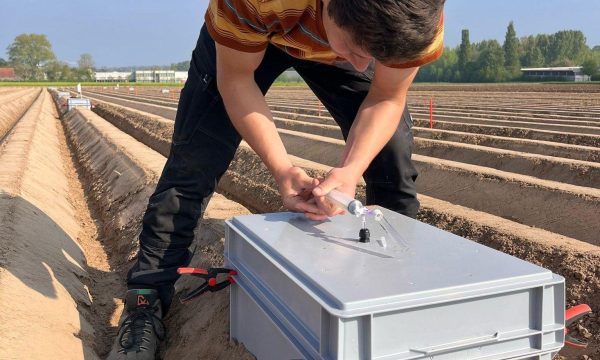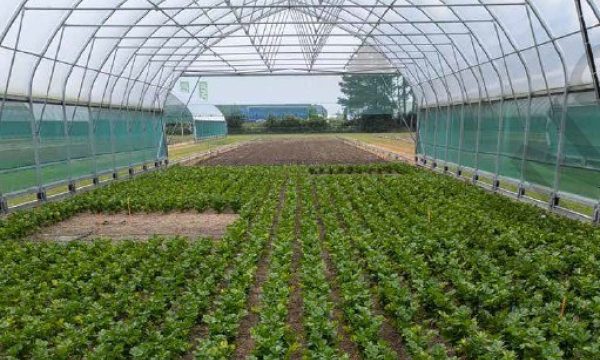Press release Agroforestry with trees rows favorable for soil quality and beneficial bugs. Total biomass yield positive.

A new study on the quantitative effects of 'ally cropping', a form of agroforestry in which rows of trees are planted in the field so that all operations with the normal agricultural machinery are still possible. Doctoral researcher Paul Pardon compared plots with mature poplars and walnut, plots with younger trees and plots without trees.
The favorable impact of alley cropping on soil quality and on the presence of pest-resistant insects is now quantitatively substantiated. Near the older rows of trees there were significantly higher concentrations of organic soil carbon in the soil and nutrients such as total nitrogen, potassium, sodium, magnesium and calcium.
The yield reduction of agricultural crops near the tree rows has also been mapped. In the 30-meter zone of the mature (highest) trees yield was one-quarter lower for potatoes and corn. Paul Pardon: 'If you calculate the revenues over the years, including the logged wood, then you will get a net higher biomass compared to the non-agroforestry system.' Pardon advises making smart choices in agroforestry. Both the tree species and the crop choice influence the result. For example, winter grain hardly suffers a loss of yield.
On 12 December 2018 Paul Pardon defended his doctorate: "Silvoarable agroforestry systems in temperate regions: impact of tree rows on crops, soil and biodiversity". Promoters of the doctorate are Prof. dr. ir. Kris Verheyen, Prof. dr. Dr. ir. Jan Mertens and Prof. dr. Dr.ir. Dirk Reheul of Ghent University and Dr. ir. ir. Bert Reubens of ILVO.
Trees as a panacea for agricultural plots
For a decade already, Europe has become more interested in agroforestry, in the search for sustainability of agriculture and land use, especially with a view to climate change. The list of benefits mentioned is long: Trees bind CO2 from the air in wood. They store carbon in the soil. They protect the soil with their roots against erosion. They provide cooling in hot weather. They provide a home and food source for invertebrates. They buffer and regulate the water management. In tropical and subtropical areas, the combined land use system (trees together on the same plot with livestock or agricultural crops) has been around for a long time. The positive effects on productivity, soil fertility and biodiversity have already been documented there. The use of agroforestry in Europe is more limited, due to uncertainties on the legal and economic level. Quantitative data on the impact on ecosystem services and actual agricultural production are still scarce. Paul Pardon: "Even in our temperate climate there is a lot of potential, including for 'alley cropping'. In addition, trees can be planted in rows on the field itself, which can be efficiently combined with the current agricultural techniques and machines for the cultivation of agricultural crops in the arable zone between the rows of trees."
Trees and the soil
Various combinations of trees / crops were examined in the doctoral study: a set of young alley cropping plots to study the effect of recently planted rows of trees and a set of arable plots flanked by a row of pruned poplars or walnut trees as an approach for older alley cropping systems. Measurements were carried out at various distances from the rows of trees, up to a distance of 30 m in the arable plot. The effect of the presence of tree rows on organic soil carbon, total nitrogen, phosphorus, potassium, magnesium, sodium, calcium and acidity was checked in the topsoil of the experimental plots. Although no effects were observed on the plots with young plantings, significantly higher concentrations of organic soil carbon and soil nutrients were observed alongside the older rows of trees. For example, in the area up to 30m in the parcel next to poplar rows, about 5 tons of carbon per hectare extra was recorded in the building sector compared to plots without trees. These increases were highly dependent on the distance to the tree rows, resulting in significant spatial gradients. In other words: the farther from the row of trees, the less pronounced the effect. In addition, the magnitude of the observed effects varied greatly depending on the type of tree and the size of the trees. For example, the increase in organic soil carbon, total nitrogen, potassium and sodium near the poplars was proportional to the size of the trees and thus also to the size of the leaf fall. This leaf fall turned out to be the most important explanatory factor for the input of carbon and nutrients.
More info about agroforestry in Flanders: www.agroforestryvlaanderen.be
Agroforestry in Flanders
More info (NL):


